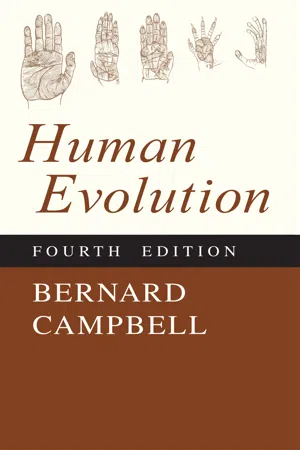Biological Fitness
Biological fitness refers to an organism's ability to survive and reproduce in a given environment. It is a measure of how well an organism is adapted to its surroundings and how successful it is in passing on its genes to the next generation. Fitness is influenced by various factors such as physical traits, behavior, and reproductive success.
3 Key excerpts on "Biological Fitness"
- eBook - ePub
Human Evolution
An Introduction to Man's Adaptations
- Bernard Campbell(Author)
- 2017(Publication Date)
- Routledge(Publisher)
...Animals must find a mate among their contemporaries, and if they mate more than once in a lifetime (as mammals do), sexual relationships will be widely spread. Thus, the unit of evolution, the breeding population, includes all the individuals able to mate with each other. The size of the population may vary, but it is the breeding unit with its network of sexual relations that evolves in the course of time. The fitness of such a population, in the biological sense, requires not only the ability to cope with the existing environment and to reproduce, but also the potential to evolve in the future in response to environmental change. This potential requires not only genetic stability (see Section VIII), which reflects the broad stability of the environment, but also genetic variability (consequent upon sexual reproduction), which reflects the instability of the environment. That is to say, a population cannot afford to vary greatly in a stable, competitive, and hostile environment, for random variation may be lethal; the population must remain well adapted. At the same time, the population must be able to evolve in adaptation to environmental change. This necessary genetic stability, accompanied by flexibility in the form of adaptability, is the basis of Darwinian fitness, and the balance struck between these two factors determines how fit a population is and the nature of its adaptation. The dynamic stability of all the genetic components of a population (called the gene pool) makes possible adaptation to the environment as well as the modification of such adaptation in the presence of environmental change in the future...
- eBook - ePub
The Age of Fitness
How the Body Came to Symbolize Success and Achievement
- Jürgen Martschukat, Alex Skinner(Authors)
- 2021(Publication Date)
- Polity(Publisher)
...Nevertheless, for Darwin fitness was not something that individual creatures actively brought about. It was not a being’s work on its performance that resulted in victory or defeat, survival or death. Rather, according to Darwin, it was contingency that determined which living creatures best fit a specific environment and therefore survived. A look at early German editions of Darwin’s book underlines this reading, which predominated in the German-speaking countries as well. Borrowing from Spencer’s Principles of Biology, these texts consistently conveyed the “survival of the fittest” by the phrase Überleben des Passendsten (implying aptness). 20 In Darwin’s work as elsewhere, fitness was still static, and the fittest was the most apt. His writings were not initially built on the notion of dynamic fitness as the effect of work on oneself and the targeted optimization of one’s potential. However, the concept of fitness as something one can and must work on in order to increase one’s chances of success and survival was no more than a small step away. Who could fail to come up with the idea of working purposefully to gain advantages and a better point of departure amid this mélange of competition, struggle, and the freedom to pursue self-care? Who would not seek to use their liberties to their own advantage in a context of inescapable competition? For the members of a society increasingly geared toward performance and competition, fitness acquired in this way would make survival more likely and thus help optimize – within and across generations – a collective that was conceptualized in both biological and social terms. Failing to work on oneself and indulging in bad habits, meanwhile, risked the degeneration and, at worst, extinction of a species. The fact that the differing scientific positions of Charles Darwin, French biologist Jean-Baptiste Lamarck, and others frequently intermingled in this discourse did nothing to stem its momentum...
- eBook - ePub
- Matthew B. Hamilton(Author)
- 2011(Publication Date)
- Wiley-Blackwell(Publisher)
...The mechanism of natural selection takes a particular form under the assumptions of the one locus selection model. Each genotype is assumed to experience genotype-specific survival and reproduction during the course of a single generation as diagrammed in Fig. 6.3. This leads to a possible reduction in the number of zygotes of each genotype present in the population at the very beginning of the life cycle of a single generation. For the time being let’s assume that any reduction in the numbers of individuals of any genotype comes exclusively from failure to survive to reproductive age but that all adults reproduce equally regardless of genotype. In this situation the fitness values of each genotype specify the probability of survival to reproduction, termed viability. Natural selection then takes the form of viability selection. Figure 6.3 A diagram of the life cycle of organisms showing some points where differential survival and reproduction among genotypes can result in natural selection. Viability is the probability of survival from zygote to adult, mating success encompasses those traits influencing the chances of mating and the number of mates, and fecundity is the number of gametes and progeny zygotes produced by each mating pair. Gametic compatibility is the probability that gametes can successfully fuse to form a zygote whereas meiotic drive is any mechanism that causes bias in the frequency of alleles found in gametes. Most models of natural selection assume a single fitness component such as viability...


